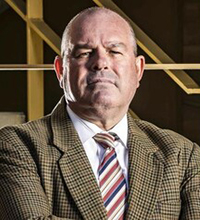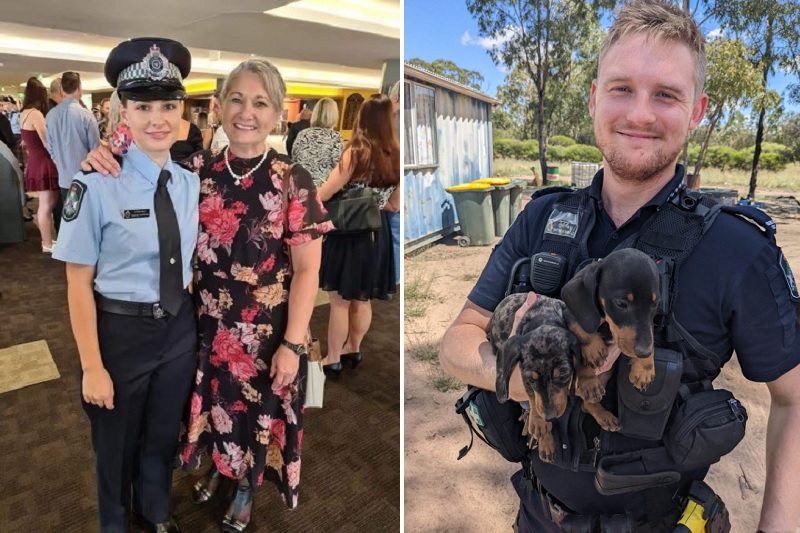On Monday night, two police officers, Constable Rachel McCrow, 29, and Constable Matthew Arnold, 26, were shot and killed, and two other officers were injured, after being ambushed by offenders at a remote property in Wieambilla, in Queensland’s Western Downs.
A civilian was also shot and killed. Specialist police then arrived at the scene, where they shot and killed three suspects, two men and a woman.
Such events are relatively rare in Australia, and shock us when they occur. So how dangerous is policing in Australia?
Have we seen previous incidents similar to this?
Reports so far indicate police attended the address at the request of New South Wales Police to conduct a missing person inquiry, and were then ambushed as they walked up the driveway of the property. This is not the first time police in Australia have been ambushed.
In 1988, two Victorian Police constables were lured to Walsh Street, South Yarra, with reports of a located stolen vehicle. Shortly after they arrived, Constables Steven Tynan, 22, and Damian Eyre, 20, were gunned down in an execution-style attack.
In 1995, two NSW police officers were gunned down while responding to an incident in the township of Crescent Head, where the offender had camouflaged himself and was armed with a high-powered rifle. The officers were armed with revolvers. The inquest into the deaths resulted in police being issued with semi-automatic pistols to better defend themselves against armed offenders.
In 2017, Queensland police officer Brett Forte was shot and killed after he and other police were ambushed by wanted suspect Ricky Maddison with an automatic weapon on a country road in the Lockyer Valley, west of Brisbane. The intelligence provided to Forte and his colleagues about the risk posed by Maddison has been the focus of coronial hearings.
How dangerous is policing in Australia?
A study into police deaths in Australia showed 28 officers were killed by attacks between 1981 and 2007. Shootings, stabbings or assaults were the main causes of attack. The study also showed that from 1981 to 2007, 22 of the police killed in attacks – or 79% – were killed by gunshot.
While the number of deaths is small, their impact on loved ones and colleagues is great. It must be acknowledged that policing is an inherently dangerous and difficult occupation.
The Australian National Police Memorial lists those police who have been killed on duty or have died as a result of their duties. Since 2010, five police have died as the result of actions of armed offenders in Australia, of these four involved firearms and one a knife.
While the number of deaths is small, their impact on loved ones and colleagues is great. It must be acknowledged that policing is an inherently dangerous and difficult occupation. In addition to fatal injuries there are significant numbers of non-fatal assaults inflicted on police. In NSW, for example, there were 2,694 reported assaults against police in 2022.
How does Australia compare to other jurisdictions?
In the United States, some 224 officers were killed as a result of attacks between 2018 and 2021. Over the same period in Australia, one police officer was killed by attack. Longer-term data in Australia indicate a rate of one officer per year being killed in attacks between 1981-2007.
Between 2010 and 2021, six police were killed in attacks in the UK: four were shot, one stabbed and another died in a car bomb explosion.
The higher rates in the US can be attributed to a higher degree of gun ownership and a higher rate of violent crime involving guns.
Where does the investigation go now?
This matter will now be referred to the coroner for an inquest, where much of the focus will be on what happened and why. The inquest will examine the circumstances leading up to the deaths, the actions of police on the day, and the response of the Queensland Police after the shootings. It will also include recommendations as to any preventative changes or policies that could reduce the likelihood of deaths occurring in similar circumstances.
But first and foremost, the police and wider community will need to mourn the senseless loss of those killed in this terrible incident.
The information that was available to attending police will also be scrutinised, as will any threat assessment conducted and the plan of approach adopted by the police in attending the incident, both initially before the ambush occurred and then when specialist squads were sent in to attend the violent scene. The intelligence made available to the attending police will be of crucial importance.
But first and foremost, the police and wider community will need to mourn the senseless loss of those killed in this terrible incident. Those involved in the incident will need to undergo a critical incident operational debrief. Ongoing psychological first aid will also be needed to support those affected. Ultimately many will be left wondering why and how this could happen.
This article is republished from The Conversation under a Creative Commons license. Read the original article.
 Dr Terry Goldsworthy is an Associate Professor of Criminology at Bond University. He has more than 28 years of policing experience in Australia, achieving the rank of Detective Inspector; he served in general duties, watchhouse and as a motorcycle officer before moving to the Criminal Investigation Branch in 1994, and spent eight years as a Detective Senior Sergeant. Dr Goldsworthy has completed a Bachelor of Commerce, Bachelor of Laws, Advanced Diploma of Investigative Practice and a Diploma of Policing. He was admitted to the bar in the Queensland and Federal Courts as a barrister in 1999; he also holds a Master of Criminology at Bond University, and later completed his PhD focusing on the concept of evil and its relevance from a criminological and sociological viewpoint.
Dr Terry Goldsworthy is an Associate Professor of Criminology at Bond University. He has more than 28 years of policing experience in Australia, achieving the rank of Detective Inspector; he served in general duties, watchhouse and as a motorcycle officer before moving to the Criminal Investigation Branch in 1994, and spent eight years as a Detective Senior Sergeant. Dr Goldsworthy has completed a Bachelor of Commerce, Bachelor of Laws, Advanced Diploma of Investigative Practice and a Diploma of Policing. He was admitted to the bar in the Queensland and Federal Courts as a barrister in 1999; he also holds a Master of Criminology at Bond University, and later completed his PhD focusing on the concept of evil and its relevance from a criminological and sociological viewpoint.
Main Picture courtesy of Queensland Police


